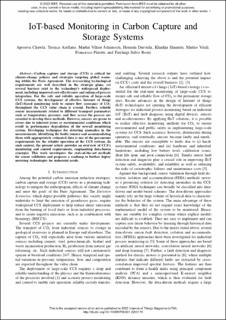| dc.contributor.author | Chawla, Apoorva | |
| dc.contributor.author | Arellano Prieto, Yessica Alexandra | |
| dc.contributor.author | Johansson, Martin Viktor | |
| dc.contributor.author | Darvishi, Hossein | |
| dc.contributor.author | Shaneen, Khadija | |
| dc.contributor.author | Vitali, Matteo | |
| dc.contributor.author | Finotti, Francesco | |
| dc.contributor.author | Salvo Rossi, Pierluigi | |
| dc.date.accessioned | 2023-01-24T14:55:43Z | |
| dc.date.available | 2023-01-24T14:55:43Z | |
| dc.date.created | 2022-11-23T11:39:50Z | |
| dc.date.issued | 2022 | |
| dc.identifier.citation | IEEE Internet of Things Magazine (IoTM). 2022, 5 (4), 106-111. | en_US |
| dc.identifier.issn | 2576-3180 | |
| dc.identifier.uri | https://hdl.handle.net/11250/3045952 | |
| dc.description.abstract | Carbon capture and storage (CCS) is critical for climate-change policies and strategies targeting global warming within the Paris Agreement. The overarching technological requirements are well described in the strategic plans, yet several barriers exist to the technology's wide-spread deployment, including improved cost-effectiveness and enhanced process integration. For the safe and reliable operation of large-scale CCS systems, the development of effective Internet of things (IoT)-based monitoring tools to ensure flow assurance of CO 2 throughout the CCS value chain is crucial. Further, reliable sensor measurements related to different transport parameters such as temperature, pressure, and flow across the process are essential to develop these methods. However, sensors are prone to errors due to inherent issues or environmental conditions which result in performance degradation of the overall monitoring system. Developing techniques for detecting anomalies in the measurements, identifying the faulty sensors and accommodating them with appropriately estimated data is one of the paramount requirements for the reliable operation of the CCS systems. In such context, the present article provides an overview of CCS's monitoring and control requirements, emphasizing data-fusion synergies. This work investigates the state-of-the-art methods for sensor validation and proposes a roadmap to further deploy metering technologies for industrial needs. | en_US |
| dc.language.iso | eng | en_US |
| dc.publisher | IEEE | en_US |
| dc.rights | Navngivelse 4.0 Internasjonal | * |
| dc.rights.uri | http://creativecommons.org/licenses/by/4.0/deed.no | * |
| dc.title | IoT-based Monitoring in Carbon Capture and Storage Systems | en_US |
| dc.title.alternative | IoT-based Monitoring in Carbon Capture and Storage Systems | en_US |
| dc.type | Journal article | en_US |
| dc.description.version | acceptedVersion | en_US |
| dc.source.pagenumber | 106-111 | en_US |
| dc.source.volume | 5 | en_US |
| dc.source.journal | IEEE Internet of Things Magazine (IoTM) | en_US |
| dc.source.issue | 4 | en_US |
| dc.identifier.doi | 10.1109/IOTM.001.2200175 | |
| dc.identifier.cristin | 2079121 | |
| dc.relation.project | Norges forskningsråd: 311902 | en_US |
| dc.relation.project | Norges forskningsråd: 327056 | en_US |
| cristin.ispublished | true | |
| cristin.fulltext | postprint | |
| cristin.qualitycode | 0 | |

